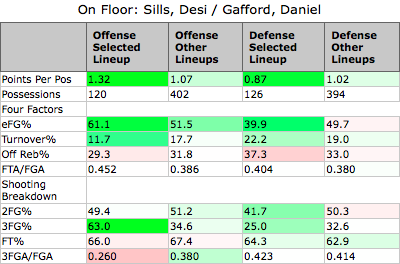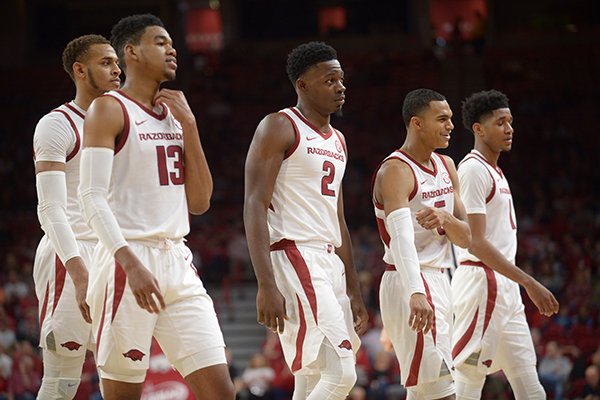Offense takes small step forward
December was a bit of a strange month for the Razorbacks offensively. They opened the month playing arguably their best ball of the season on that end of the floor, then opponents began dictating the pace of games and Arkansas fell into a funk.
But let's go back and look at those games against Florida International and at Colorado State first because those were impressive in their own ways. Arkansas scored 121 points in the win over the Panthers to open the month, averaging 1.29 points per possession over an incredible 94 possessions. For context, the Razorbacks had only 82 possessions in their overtime loss to Texas to begin the season.
Isaiah Joe was obviously the story in that win, scoring 34 points on 10/13 from 3-point range to tie assistant coach Scotty Thurman for second-most points in a game by a freshman. Daniel Gafford added a 23-point, 12-rebound double-double on top of Joe's night, and Jalen Harris finished one point shy of his second points-assists double-double in three games.
Arkansas' next game out was impressive, too. The way the Razorbacks won the game was fairly stunning, blowing out Colorado State on its home floor with a display of chemistry, togetherness and unselfishness. Harris led Arkansas with 12 more assists and guided the offense to its highest PPP mark in years – 1.40. Arkansas' offensive rating - points produced per 100 possessions - of 139.1 is tied for second best in Mike Anderson's tenure with the program.
Arkansas then failed to score 80 points over its final five games of the month, finishing 3-2 with losses to Western Kentucky and Georgia Tech in Bud Walton Arena, which is a little out of character for even some of Anderson's less-talented teams.
To close the calendar year, the Razorbacks averaged 1.034 points per possession in their last five games. Their best game in that span - against Texas-San Antonio in North Little Rock - saw the offense score at a 1.10 PPP clip. Arkansas' next game, against Georgia Tech, was its worst offensive showing (.92 PPP) since the season opener in El Paso. The Razorbacks struggled mightily to properly attack the Yellow Jackets' zone defenses.
Arkansas finished the night 15/42 shooting, 7/21 from distance and turned the ball over 12 times in 52 possessions against the Yellow Jackets' zones. It had similar issues against Western Kentucky's half-court defenses, but Arkansas' defense was its own worst enemy that day.
During the Razorbacks' rough stretch that began with the Western Kentucky loss, Anderson and players often spoke to playing at the 'Fastest 40' tempo and not allowing teams to control the pace of games.
According to HoopLens analytics, Arkansas' pace was significantly slower in December than November. The Razorbacks averaged 78.6 offensive possessions the first month of the season versus 74.6 last month - and that includes the 94 possessions against FIU. In the six games following FIU, Arkansas averaged just 71.3 offensive possessions per game.
Defense remains a strength
Arkansas' defense in November was as good as any team Anderson has had in recent memory, so expecting it to remain that solid against an uptick in competition in December is unfair. But saying the Razorbacks' defense is still a team strength isn't a stretch at all.
The Razorbacks will likely have to continue to hang their hat on that end to find success early in SEC play. Over the last five seasons, Arkansas' offensive efficiency numbers tend to drop fairly significantly in January vs. December as Anderson's teams adjust to much stiffer opposition.
Last month, though, Arkansas truly slipped up on the defensive end just once - against Western Kentucky. The Razorbacks allowed the Hilltoppers to score at a 1.10 PPP rate, by far the highest mark of the month. Colorado State's offense scored at a 1.06 PPP clip, but it didn't much matter with Arkansas' offense rolling the way it was. Aside from a 17-2 run in the second half, Arkansas dominated the game on both ends.
Outside of Western Kentucky and Colorado State, the Razorbacks' defense was fantastic again. FIU, UTSA, Georgia Tech, Texas State and Austin Peay combined to score just .952 PPP over 379 possessions. Arkansas held those five teams to 26.1 percent from 3-point range and turned them over on better than 21 percent of their offensive trips.
But in the losses to Western Kentucky and Georgia Tech, the Razorbacks allowed them to shoot 54.1 percent on looks inside the 3-point arc, 36 percent from deep and rebound nearly 35 percent of their misses. Arkansas turned the teams over on more than 24 percent of their offensive possessions, but it didn't make much of a different because the Razorbacks' offense was so flat and complacent.
In December, Arkansas allowed its seven opponents to shoot just 41 percent from the floor and 31 percent from 3-point range - both numbers you'll likely live with. The Razorbacks even averaged nearly 6.5 blocked shots per game last month, but teams were able to hang around thanks to second-chance points and Arkansas' poor defensive rebounding. Opponents grabbed an average of 11.1 offensive rebounds per game. Arkansas gave up 30 over its final two games of the year and at least 15 three times.
So imagine how good Arkansas' defense could have been if it would have finished possessions with a defensive rebound.
Adrio Bailey's struggles
The beginning of December was simply a continuance of November for Bailey, reaching double figures against FIU and Colorado State in a pair of nice wins. Bailey stuffed the stat sheet against the Rams, finishing just two rebounds shy of a double-double. It was his fourth consecutive game with 10-plus points and fifth such game of the year.
Then, oddly, something changed, and Bailey's offensive game shifted toward the wildly inconsistent play we saw in conference play last season.
After scoring a career-high 11.2 points per game in Arkansas' first five games this season, he scored a mere 3.9 on 12/32 from the floor (38 percent). Rebounds were slightly up over last month, as were blocks, but steals and assists both dropped and turnovers and fouls committed rose month over month. And he shot 3/10 at the line.
Prior to the Austin Peay game, Bailey said he attributed his struggles - 2 points, 1/16 shooting - to settling a bit too much with his jumpshot rather than using his athleticism to attack the basket. Through nonconference play, Bailey is 11/24 on midrange jumpers, including 4/10 on the left side of the floor and 3/9 on the right.
In Arkansas' motion offense, Bailey tends to float out toward the 3-point line at times following his initial screen action, putting himself in position for inefficient long 2s and shots Anderson could probably live without. He is 3/9 on long 2s this season. I always thought he could be much more effective running the short corners and elbows.
Bailey's poor play led to Anderson shaking up his lineup for the first time this season, replacing the junior with freshman Reggie Chaney. Chaney was very up and down in his first start, and Bailey was back in the lineup to close out 2018 against Austin Peay, when he scored five points in the first 90 seconds of the second half after scoring just two over his previous 67 minutes played.
We'll see if Bailey plays any better to open conference play, but history says it isn't likely. January, statistically, is his worst month, averaging 1.3 points in 13 games played.
Stray thoughts
– Reggie Chaney and Daniel Gafford are beginning to play together more and more, and the results have been very positive. Arkansas allowed just .84 points per possession when the two shared the floor in December, and opponents shot under 38 percent on 2-point looks and 27 percent from distance over those 132 defensive possessions. About the only hiccup with that pairing is that teams are rebounding better than 34 percent of their misses. That number drops to a respectable 28.7 percent when Gafford and Bailey are sharing the court.
– Speaking of pairings, Arkansas' best two-man pairing in December in terms of PPP differential: Daniel Gafford and Desi Sills. Check out these numbers:

Daniel Gafford and Desi Sills' on-court numbers for December.
Sills, outside of Chaney, had about the most consistent month of any Arkansas role player. He began the month scoring at least six points in the team's first five games. He did not score in the final two games of 2018, but did finish with seven assists. Over 225 offensive possessions in December, Arkansas scored at a 1.14 clip with Sills on the floor, up from the team's monthly 1.12 PPP clip. The Razorbacks shot 45 percent from deep in that span, and 37 percent when Sills sat.
Also, opponents shot just 25.3 percent from 3 when Sills was on the floor last month.
– Over Arkansas' last two games, Gabe Osabuohien's passing really stood out. Against Texas State, he tied a team-high with four assists in the win, and last Friday night he totaled three more, giving him seven over his last two outings. It's impressive for a couple of reasons:
1 - Gabe had seven assists this season entering the Texas State game and did not have an assist in the four games leading up to it.
2 - Gabe had seven assists all of his freshman season.
Over the last couple of games, we've seen Gabe take a something of a step forward in terms of playing within himself on the offensive end. He's often times tried far too hard to go get his and score whenever the ball touches his hands. But lately, he's found Reggie Chaney and Daniel Gafford for scores on some really great looks.
– Isaiah Joe, entering the Georgia Tech game was shooting 63.2 percent from 3-point range. There was always a good chance that number wouldn't hold, but he still had a shot to put up an impressive month from the 3-point line. He did, even after experiencing a 4/17 slump in the Georgia Tech and Texas State games. After shooting 36 percent from deep in November - which we thought was still pretty good - Joe shot 52 percent from 3 last month. Impressive. Through nonconference play, Joe is 20/43 from deep on the left side of the floor, 5/18 in the middle third and 15/30 to the right of the key.
– Last but not least, Jalen Harris turned in a tremendous month distributing the basketball. At New Mexico as a freshman, Harris never finished with more than 28 assists in any month. Through two months at Arkansas, he's done it twice. He totaled 29 assists against six turnovers in November and a whopping 51 versus eight turnovers in December despite playing 64 more minutes last month than the first month of the season. Harris turned in three double-digit assist games in December and had just three turnovers total in those games. If there is one knock on Harris at the moment, it's his jumper. He missed his first 13 3-point attempts in December before hitting his only one to essentially seal the win against Austin Peay last week.

